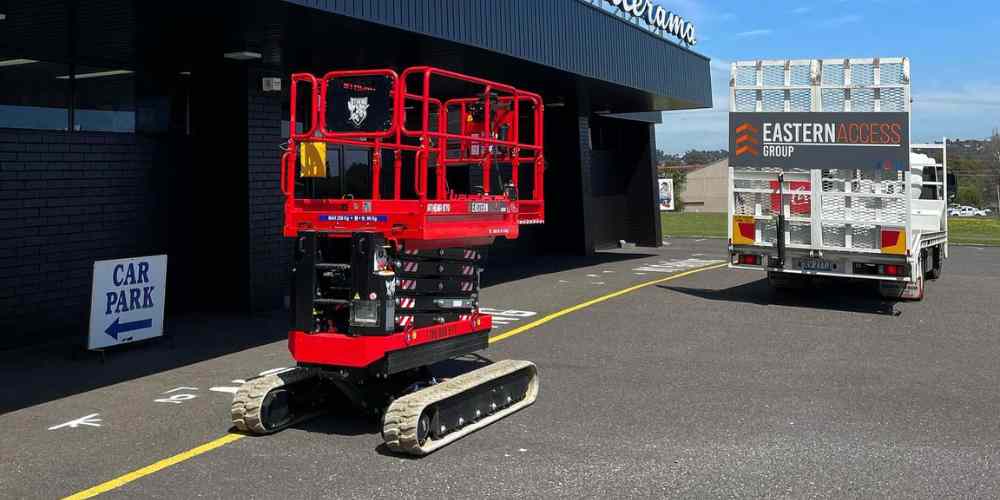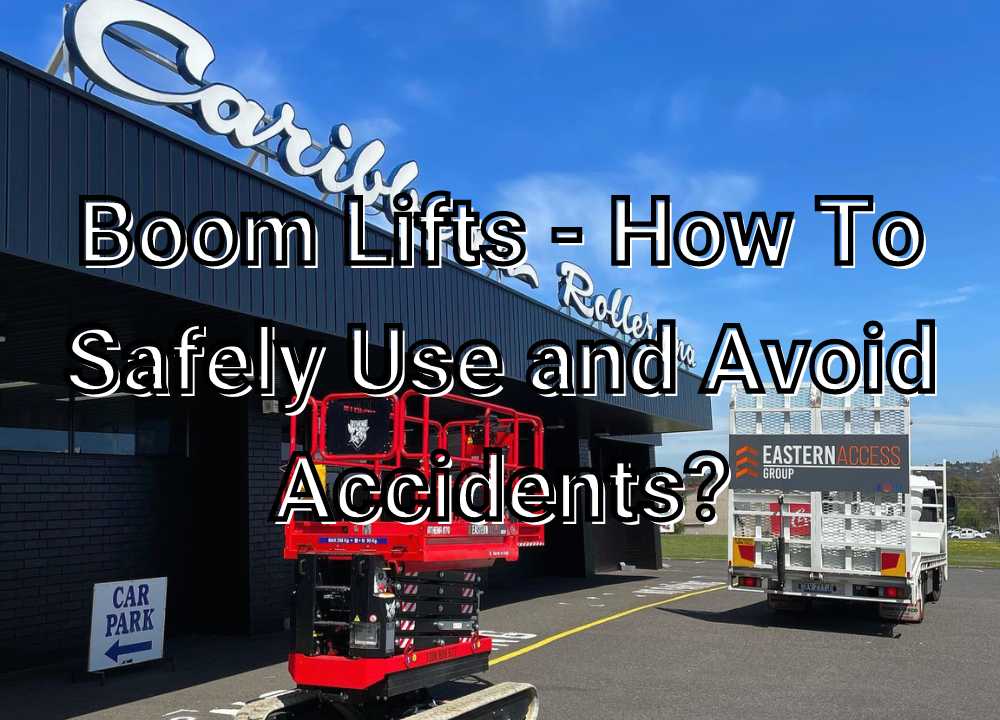Boom Lifts - How To Safely Use and Avoid Accidents?
A boom lift is a flexible tool for various construction and maintenance tasks. Boom lifts come in various kinds and models, so getting to know your equipment is essential to use it efficiently. In addition to having access to the manufacturer’s handbook, a lift operator should also be OSHA-certified and have received training before using it.
Although they may seem obvious, reviewing and adhering to guidelines when using them can make the difference between remaining safe and being hurt.
Read on and learn essential safety tips you should follow when using boom lifts to avoid unwanted accidents.
Table of Contents

Important Safety Tips When Using Boom Lifts To Avoid Workplace Injury
Keep your base and perimeter uncluttered.
Always ensure nobody is within the boom lift’s base or around its whole perimeter when it is in operation. Tools might easily fall from the platform when the lift’s radius is large, dangerously hurting anyone standing below. Keeping the space free reduces the possibility of something falling and hitting someone below.
Make Sure Operators Are Trained
Operator mistakes bring on most boom lift accidents in Australia. Therefore, all boom lift operators must receive the appropriate training. Aerial lift placement and stabilisation, as well as fall prevention, should be taught to all operators. Tests should be administered to all candidates to guarantee that all new hires have enough operating understanding of the boom lift. Additionally, boom lift operators must have the ability to identify any problems before they become serious.
Avoid going beyond the load capacity.
Boom lifts have constraints. Like any equipment, it’s critical to be aware of and follow them. For the weight and height restrictions while handling cargo, read and abide by the manufacturer’s instructions. Remember that the platform’s weight restrictions apply to the operators, equipment, and other materials. It’s critical to determine the total weight of all these components before using the lift. Remember that boom lifts aim to raise workers and equipment into a working space. They are not designed to hoist significant materials; thus, if you need to move heavy items, utilise a crane.
Put on your safety harness.
Wearing a harness and ensuring the lanyard is completely fastened to the bucket are two easy but crucial safety precautions. Even a little jolt from another piece of machinery or item can knock an operator off balance and put them in danger of falling, even though it might seem implausible. Even a strong wind gust has the potential to seriously hurt someone by knocking them to the ground or off the platform.
Stay out of the wind.
The wind may be a severe safety risk when a boom lift is stretched very high. High wind can entirely knock over a boom lift. Boom lifts should not be used in severely windy or inclement weather since they might topple over. Each lift has a maximum amount of wind it can tolerate; reading the user handbook will assist the operator in comprehending the particular limitations of the lift they are operating and identifying techniques for utilising the lift in challenging weather.
Avoid sitting or climbing on the edges.
When standing on a boom lift platform, it’s simple to be tempted to climb up the edge rather than moving the boom lift as a whole to reach anything. However, more people should be made aware of how harmful this is. One’s risks of falling off the platform and the potential for catastrophic damage are significantly increased by climbing or sitting on the platform’s edge. When anything is out of reach, let the boom lift operator know so you may move to a secure spot on the platform from where you can efficiently address the obstruction.
Stay out of the wind.
The wind may be a severe safety risk when a boom lift is stretched very high. High wind can entirely knock over a boom lift. Boom lifts should not be used in severely windy or inclement weather since they might topple over. Each lift has a maximum amount of wind it can tolerate; reading the user handbook will assist the operator in comprehending the particular limitations of the lift they are operating and identifying techniques for utilising the lift in challenging weather.
Keep Enough Space Between You and Power Lines
In boom lift operations, electrocution ranks among the top three most common causes of injury or death. This shouldn’t be surprising considering the heights at which boom lifts are frequently employed. When using a boom lift, there is a reasonable probability that you may come into contact with electricity wires at some time. Thus it’s critical to keep a safe distance from them. It is advised to keep a minimum of 10 feet (3 metres) between the lift and the electrical wires at all times. Even if they appear insulated or you have been assured they are down, power lines should always be handled as live wires. It is preferable to be careful.
Move around the lift properly.
An operator can better grasp how to operate the boom lift and when it is and is not safe to move it while extended by carefully reading the manufacturer’s handbook. However, it’s frequently preferable to avoid relocating the lift in this way as a best practice. Only move a lift while extended if essential and only if the manufacturer’s handbook permits it. Doing otherwise increases the risk of damage. If not, one should lower the boom lift, relocate it, and extend it where necessary.
Most Common Boom Lifts Accidents That Must Be Avoided
Falling from the boom lift
Falls are one of the most frequent causes of injury and death for aerial and scissor lift workers since they work at a height. Workers should refrain from frequently growing complacent and rely on their talents rather than safety equipment. When operating a lift, unexpected events might occur. Employees must always stay inside the bucket by climbing over the edge. Employees may be fully prepared to follow the proper procedures before and during lift use with online fall protection training.
Tipping over
Scissors and aerial lifts are prone to toppling over in the wrong situations. Once the centre of gravity is wrong, it’s regrettably not difficult for the entire machine to collapse over. This can happen if the cargo is off-centre or a worker is leaning out of the lift.
Electrocution
Electrocution from overhead power lines is one of the most common reasons for accidents and fatalities on aerial and scissor lifts. Many different things might lead to this. Either the person or the piece of equipment might make direct contact with the electrical line. Not dressing appropriately is also a contributing cause. Always presume that a power line is in use, and keep a 10-foot distance between yourself and it if you aren’t working directly with it.
Frequently Asked Questions
Boom lifts are simple to set up and use if you know how to use them securely and effectively. Consider the variety of boom lifts for sale at our heavy-duty construction equipment provider if your work calls for an economical option for getting to confined spaces. Additionally, we rent out boom lifts that may be used for several tasks.
Naturally, there is a danger associated with high power; frequent boom lift mishaps include falls, tip-overs, and electric shocks from coming into contact with electrical lines. Manlift mishaps can result in severe injuries if inadequate training and care are not taken with safety procedures.
It is significant to remember that while the battery is being charged, you can still use your scissor lift. All you have to do to stop the equipment from rolling is to pull out the red emergency shut-off button and have a helper direct the extension line away from the wheels.
As long as you don’t go over the maximum slope with a safe working weight for the boom lift, it is possible to work on an incline. Knowing the lift’s maximum slope rating is crucial for safely operating a boom lift on a slope.
Conclusion
Boom lifts are crucial to the effective deployment and completion of many construction projects. However, due to its size, scale, and construction, this equipment may also be dangerous and seriously hurt people if proper safety precautions are not taken.
The deadly accident may have been prevented with the appropriate training. However, industrial accidents such as scissor lift accidents and boom lift accidents occur annually. Anyone who uses aerial lifts should thus be adequately trained and certified.
Using boom lifts may be challenging and dangerous. Still, by following these safety guidelines, you can reduce the chance of mishaps and injuries while you’re working.

